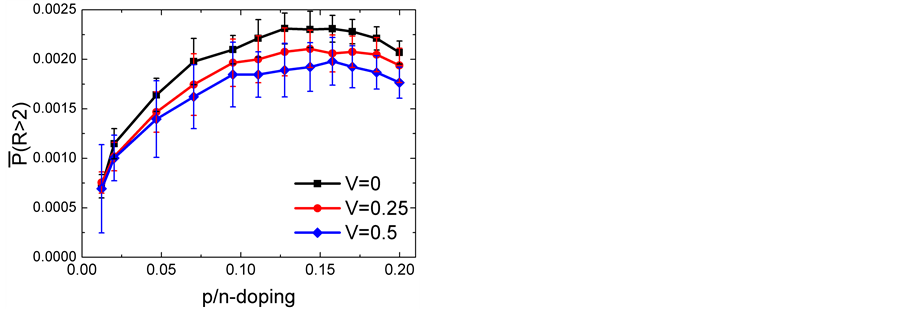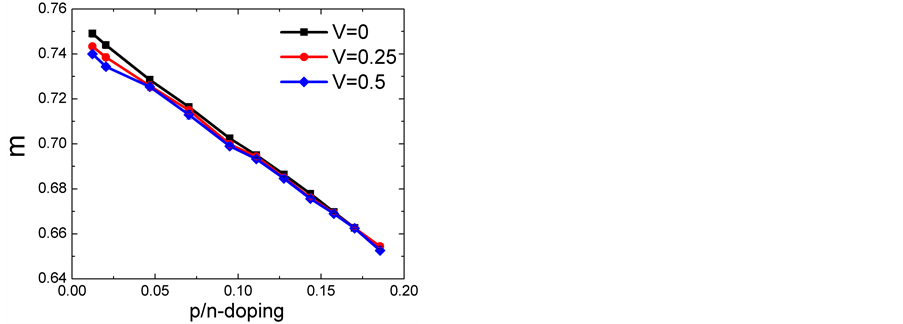1. 引言
近年来,关于激子态的研究受到了凝聚态物理学家的广泛关注,如何克服固体材料中由于电子和空穴的不断复合而影响激子态的凝聚是一个亟需解决的问题[1] [2] 。人们设想,可以把电子和空穴分别分布在两个层中,依靠电子和空穴间的库仑作用力来形成比较稳定的电子–空穴对,即激子态,这样能有效减小电子–空穴复合湮灭的几率 [3] [4] 。石墨烯的发现进一步促进了人们对这种结构的认识,借助于一个双层石墨烯结构,可以比较容易地实现电子和空穴的分层分布 [5] - [7] 。人们预言,在这样的一个双层结构中,当外加磁场强度为零时,在某一个有限温度下,层间会出现激子的凝聚现象 [2] 。
在理论研究方面,人们采用多种理论方法分析了双层石墨烯和其他双层多电子体系 [8] [9] 的激子态特性。Dillenschneider等人采用哈特利-福克近似方法探讨了带偏压双层石墨烯中的激子态特性 [10] ,发现当层间库仑相互作用大于一临界值(依赖于电压偏差和层间电子跃迁积分),体系中存在稳定的激子态。Song等人采用单圈微扰重正化群方法探讨了未掺杂双层石墨烯体系的电子态 [11] ,计算结果表明由于体系具有完美的粒子–空穴嵌套特性,电子间的相互作用将导致铁磁态、超导态、自旋和电荷密度波、以及激子态的出现,而且除超导态外其它状态均为绝缘态。基于数值精确对角化方法,Kaneko等人探讨了Falicov- Kimball模型描述双层多电子体系中的激子态特征 [12] ,发现随着层间库仑相互作用的增加,激子态表现出由Bardeen-Cooper-Schrieffer (BCS)凝聚过渡到Bose-Einstein凝聚。最近,Rademaker等人采用有限温度行列式量子蒙特卡罗方法研究了双层哈伯德模型中的激子态特性 [13] 。他们发现当电子和空穴掺杂浓度处于10%~20%区间时,体系存在较为稳定的局域激子态,但是“负符号”问题导致难以确定体系是否存在激子凝聚态。
目前,关于激子态的研究尚存诸多问题,包括是否存在激子凝聚态、凝聚态属性、电声子相互作用和无序对凝聚态的影响、以及激子凝聚态引起的物理效应等 [13] - [15] 。在本工作中,为了进一步理解双层哈伯德模型中激子态与电子和空穴掺杂浓度的关系,以及是否存在激子凝聚态这一重要问题,我们采用约束路径量子蒙特卡罗方法 [16] 系统地研究了双层哈伯德模型的零温基态特性。
2. 模型结构和哈密顿量
我们考虑一个由两个单层方形格子组成的双层结构,如图1所示。该双层结构的模型哈密顿量可以写为下面的形式:
 (1)
(1)
在该表达式中 代表电子跃迁对应的动能部分,
代表电子跃迁对应的动能部分, 是同一个格点上电子双占据(自旋向上和自旋向下)时的在位库仑相互作用项,
是同一个格点上电子双占据(自旋向上和自旋向下)时的在位库仑相互作用项, 则表示层间电子-电子库仑相互作用项,亦即层间电子–空穴之间的吸引相互作用。它们分别表达为下面的形式:
则表示层间电子-电子库仑相互作用项,亦即层间电子–空穴之间的吸引相互作用。它们分别表达为下面的形式:
 (2)
(2)
 (3)
(3)
 (4)
(4)
这里 分别代表格点上电子的产生(湮灭)算符,
分别代表格点上电子的产生(湮灭)算符, 代表电子的密度算符,
代表电子的密度算符, 代表自旋。
代表自旋。 代表格点上电子的势能,
代表格点上电子的势能, 。图1中
。图1中 和
和 分别代表层内和层间电子跃迁积分,U和V代表在位和层间库仑相互作用。我们将以电子半填充
分别代表层内和层间电子跃迁积分,U和V代表在位和层间库仑相互作用。我们将以电子半填充 作为出发点,通过调节格点势能
作为出发点,通过调节格点势能 使得两层分别为电子和空穴掺杂,且掺杂浓度大小相等。
使得两层分别为电子和空穴掺杂,且掺杂浓度大小相等。
为了与Rademaker等人的有限温度结果 [15] 进行比较,同时考虑到层间相互作用V的引入将对数值模拟带来很大的困难,我们将集中模拟沿层面x和y方向边长为6的晶格(晶格常数 = 1),即取 ,该晶格包含的格点总数为
,该晶格包含的格点总数为 。哈密顿量(2)~(4)中的参数取值为:
。哈密顿量(2)~(4)中的参数取值为: ,
, ,
, ,这里层内电子跃迁积分
,这里层内电子跃迁积分 选作能量单位。
选作能量单位。
根据式(2)给出的哈密顿量可以方便地获得由单个斯莱特行列式表示的自由电子波函数,然后采用约束路径量子蒙特卡罗方法 [16] 投影得到相互作用多电子体系的基态波函数,从而计算出物理量在基态中的期待值。下列公式中符号<…>表示基态中的期待值。
层间激子的序参量定义为如下:
 (5)
(5)
由于哈密顿量(3)~(4)中较强的局域相互作用,激子的形成是局域化的。因此激子的序参量可以看做不依赖电子的动量,从而可以把它重新写为:
 (6)
(6)
上式表明局域激子态由层间的单粒子隧穿强度加以表征。理想的激子凝聚指的是当层间的电子跃迁完全被抑制时层间电子和空穴的配对情况。然而基于上述激子序参量的定义,此时该隧穿强度完全为零。因此我们需要考虑一个有限的层间跃迁积分,类似于引入一个外加的电场或磁场使体系产生电极化或者磁化从而便于探测其物理特性。
为了考察双层哈伯德模型是否呈现激子凝聚态,我们定义激子的空间关联函数为:
 (7)
(7)
这里R表示i和j格点激子之间的空间距离。
3. 计算结果与讨论
首先我们考察双层哈伯德模型的局域激子态特征。图2(a)表示层间库仑相互作用V取不同值时,局域激子序参量 随电子和空穴掺杂浓度p/n-doping的演化行为。当V一定时,可以看出
随电子和空穴掺杂浓度p/n-doping的演化行为。当V一定时,可以看出 刚开始随着掺杂浓度的增加而逐渐增大,然后在更大掺杂浓度区间趋于达到饱和值。随着掺杂浓度的增加,层间原则上可以形成更多分布在不同格点的激子态,导致式(6)中的求和增大,该行为可以可以解释图2(a)中低掺杂区域的激子态特征。当掺杂浓度大于0.1时,电子的层内跃迁相对于库仑相互作用将处于主导地位,并影响激子态的形成,从而导致
刚开始随着掺杂浓度的增加而逐渐增大,然后在更大掺杂浓度区间趋于达到饱和值。随着掺杂浓度的增加,层间原则上可以形成更多分布在不同格点的激子态,导致式(6)中的求和增大,该行为可以可以解释图2(a)中低掺杂区域的激子态特征。当掺杂浓度大于0.1时,电子的层内跃迁相对于库仑相互作用将处于主导地位,并影响激子态的形成,从而导致 呈现出趋于饱和值的特征。由图2(a)我们还可以看出当掺杂浓度低于0.08时,
呈现出趋于饱和值的特征。由图2(a)我们还可以看出当掺杂浓度低于0.08时, 随着V的增加而逐渐增大,而当掺杂浓度高于0.08时,
随着V的增加而逐渐增大,而当掺杂浓度高于0.08时, 随着V的增加而逐渐减小。该结果表明在低掺杂区域层间库仑相互作用有助于局域激子态的形成。为了更为清晰地观察V的效应,我们在图2(b)给出V = 0.25和0.5对应的
随着V的增加而逐渐减小。该结果表明在低掺杂区域层间库仑相互作用有助于局域激子态的形成。为了更为清晰地观察V的效应,我们在图2(b)给出V = 0.25和0.5对应的 与无层间相互作用情况下的差值随掺杂浓度的演化行为。我们可以看到当掺杂浓度低于0.08时,该差值随掺杂浓度的增加而减小,而当掺杂浓度高于0.08时,该差值基本保持一恒定的负值。
与无层间相互作用情况下的差值随掺杂浓度的演化行为。我们可以看到当掺杂浓度低于0.08时,该差值随掺杂浓度的增加而减小,而当掺杂浓度高于0.08时,该差值基本保持一恒定的负值。
图2(b)显示的结果与Rademaker等人的有限温度结果 [15] 存在显著的差异。他们发现在整个掺杂区域,有限V对应的 均大于V = 0对应的值,而且在掺杂浓度处于10%~20%区间时,两者之间的差值呈现出峰值,说明V在中等掺杂浓度时对局域激子态的增强效应最为明显。我们的零温基态计算结果与有限温度计算结果之间的差异证明体系的物理特性随着温度的逐渐降低将发生显著的变化,进一步的低温数值模拟工作将有助于理解体系的磁性、电荷关联、激子态等随温度的演化特征。
均大于V = 0对应的值,而且在掺杂浓度处于10%~20%区间时,两者之间的差值呈现出峰值,说明V在中等掺杂浓度时对局域激子态的增强效应最为明显。我们的零温基态计算结果与有限温度计算结果之间的差异证明体系的物理特性随着温度的逐渐降低将发生显著的变化,进一步的低温数值模拟工作将有助于理解体系的磁性、电荷关联、激子态等随温度的演化特征。
根据图2的结果可以确定双层哈伯德模型在电子和空穴等量共掺的情况具有稳定的局域激子态,但我们需要回答一个重要的问题:模型是否具有激子凝聚态?按照式(7)的定义,当激子的长程空间关联函数在热力学极限下取有限值时,体系将呈现出激子凝聚态。
图3给出电子和空穴掺杂浓度p/n-doping = 0.055和0.098,V取不同值时激子的空间关联函数P(R)随着激子间距R的变化特征。我们可以看出当距离大于2时,P(R)随着V的增加而减小,特别是V = 0.5时,该减弱效应最为明显。图3的结果说明不论是局域激子态被V增强或者减弱,激子之间的关联却总是被V减弱。当V = 0时,由于电子–空穴对缺乏吸引相互作用,因而体系不具有激子凝聚态,即在热力学极限下激子的长程空间关联函趋于零。由于有限V对应的P(R)小于V = 0对应的值,因而可以确定体系中即使存在电子–空穴对吸引相互作用,仍然不具有激子凝聚态。
图4给出激子的空间关联函数平均值 随掺杂浓度的变化特征。可以发现在几乎整个掺杂区域,
随掺杂浓度的变化特征。可以发现在几乎整个掺杂区域, 均随着V的增加而减小,该结果说明双层哈伯德模型在中等电子关联(U~4)时难以形成激子凝聚态。在靠近半填充(对应掺杂浓度为0)时,计算结果存在较大的统计偏差,这对确定在极低掺杂浓度区域是否存在激子凝聚态带来很大的困难。
均随着V的增加而减小,该结果说明双层哈伯德模型在中等电子关联(U~4)时难以形成激子凝聚态。在靠近半填充(对应掺杂浓度为0)时,计算结果存在较大的统计偏差,这对确定在极低掺杂浓度区域是否存在激子凝聚态带来很大的困难。
我们最后以格点磁矩为例考察了层间库仑相互作用V对体系其它物理特性的影响。格点磁矩定义为: 。图5表示格点磁矩随电子和空穴掺杂浓度的演化关系。可以清晰地看出随着掺杂浓度的增加,格点磁矩呈现出线性下降的趋势,表明电子态的局域化被掺杂减弱。图5中的三条曲线与V的依赖关系很小,表明V对电子态的局域特性影响很弱。由于层间电子跃迁积分很小,单个电子的特性主要受层内电子跃迁t和在位库仑相互作用U的影响,而层间相互作用V主要影响层间电子–空穴对即激子态的形成和稳定性。
。图5表示格点磁矩随电子和空穴掺杂浓度的演化关系。可以清晰地看出随着掺杂浓度的增加,格点磁矩呈现出线性下降的趋势,表明电子态的局域化被掺杂减弱。图5中的三条曲线与V的依赖关系很小,表明V对电子态的局域特性影响很弱。由于层间电子跃迁积分很小,单个电子的特性主要受层内电子跃迁t和在位库仑相互作用U的影响,而层间相互作用V主要影响层间电子–空穴对即激子态的形成和稳定性。
4. 结论
我们采用约束路径量子蒙特卡罗方法研究了双层哈伯德模型中的基态特性,特别是激子的局域行为和长程关联特征。研究结果表明当空穴和电子掺杂浓度低于0.08时,局域激子态被层间库仑相互作用V增强,而当空穴和电子掺杂浓度高于0.08时,局域激子态却被V减弱。关于激子的长程空间关联函数计算结果表明在研究的参数区间双层哈伯德模型不具有激子凝聚态。此外,我们发现层间库仑相互作用对电子态的局域特性影响很小。我们的零温结果与前期发表的有限温度结果存在显著差异,为理解双层哈伯德模中的激子态特征提供了新的理论依据。
 (a) (b)
(a) (b)
Figure 2. (a) The local exciton order parameter as a function for V = 0, 0.25 and 0.5; (b) the difference of local exciton order parameter at V = 0.25 and 0.5 from the one at V = 0 as a function of the p/n-doping.
图2. (a) V = 0.0,0.25,0.5时,局域激子序参量与掺杂浓度p/n-doping的依赖关系;(b) V = 0.25,0.5对应的激子序参量和V = 0.0对应值之间的差值与掺杂浓度的依赖关系
 (a) (b)
(a) (b)
Figure 3. The dependencies between the exciton correlation function and the exciton space distance when V is different. The p/n-doping is 0.055 and 0.098 in fig (a) and fig (b)
图3. V取不同值时,激子关联函数与激子空间距离之间的依赖关系。(a)和(b)对应的掺杂浓度p/n-doping分别取0.055和0.098

Figure 4. The average exciton correlation function  as a function of p/n-doing at different V
as a function of p/n-doing at different V
图4. V取不同值时,激子关联函数平均值 随空穴和电子掺杂浓度的变化情况
随空穴和电子掺杂浓度的变化情况

Figure 5. The local moment m as a function of p/n-doping at different V
图5. V取不同值时,格点磁矩随空穴和电子掺杂浓度的变化关系
致谢
感谢湖北大学物理与电子科学学院同组的杨辉、关莹和方世超的交流讨论。
基金项目
国家自然科学基金(批准号:11174072,91221103)资助的课题。